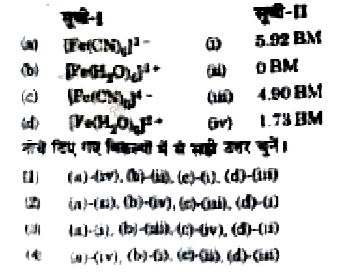रासायनिक अभिक्रिया
N2(g)+3H2(g)⇔2NH3(g) के लिए सही विकल्प है
−13d[H2]dt=12d[NH3]dt
−d[N2]dt=2d[HH3]dt
−d[N2]dt=12d[NH3]dt
3−d[H2]dt=2d[NH3]dt
The correct Answer is:C
अभिक्रिया की दर =
अभिकारक की सांद्रता में कमी
या उत्पाद की सांद्रता में वृद्धि लिया गया समय
दी गई अभिक्रिया के लिए,
N2(g)+3H2(g)⇔2NH3(g)
अभिक्रिया की दर = −d[N2]dt
=−13d[H2]dt=+12d[NH3]dt
∴ विकल्प (c ) सही है।
Topper's Solved these Questions
Similar Questions
N-यौगिकों में इनकी ऑक्सीकरण अवस्थाओं का घटता हुआ सही क्रम है
View Solutionसूची-I का मिलान सूची-II से करें।

नीचे दिए गए विकल्पों में से सही उत्तर चुनें।
View SolutionFor the synthesis of ammonia, K_c is 1.2 at 375^@C,N_2(g)+3H_2(g)hArr 2NH_3(g) What is K_p at this temperature ?
View SolutionFor the reaction, N_2(g) +3H_2(g)hArr 2NH_3(g), DeltaH^@=-ve the number of moles of H_2 at equilibrium will increases when
View SolutionWhich of the following factors favour the reaction: N_2(g) + 3H_2(g) hArr 2NH_3(g) DeltaH =-93.6 kJ
View SolutionK_C/K_P for the reaction, N_2(g) + 3H_2(g) hArr 2NH_3(g) is ……………………. .
View SolutionDerive a general expression for the equilibrium constant K_P and K_C for the reaction. 3H_2(g) + N_2(g) hArr 2NH_3(g)
View SolutionThe value of K_p for the reaction N_2(g) + 3H_2(g) hArr 2NH_3 (g) is ____ than K_c .
View Solutionअभिक्रिया N2(g)+3H2(g)⇔2NH3(g),ΔH=−93.6 kJ में अमोनिया का उत्पादन नहीं बढ़ेगा, जब-
View SolutionWhat is concentration quotient ? Write concentration quotients for the the following reactions:
N2(g)+3H2(g)⇔2NH3(g)
View SolutionApply law of mass action to the process, N_2(g) + 3H_2 (g) hArr 2NH_3 (g).
View SolutionIn the reaction,
N2(g)+3H2(g)⇔2NH3(g)
the value of the equilibrium constant depends on
View SolutionFor the reversible reaction
N2(g)+3H2(g)⇔2NH3(g)+Heat
The equilibrium shifts in forward directions.
View SolutionFor the reactions, N_2(g) + 3H_2(g) hArr 2NH_3(g), " " K_p=K_c (RT)^(…..)
View SolutionN2(g)+3H2(g)→2NH3(g),ΔH=−92.3kJ
2NH3(g)→N2(g)+3H2(g),ΔH=…….kJ
View SolutionFor the reaction, N_2[g] + 3H_2[g] hArr 2NH_3[g] , Delta H = …
View Solution
